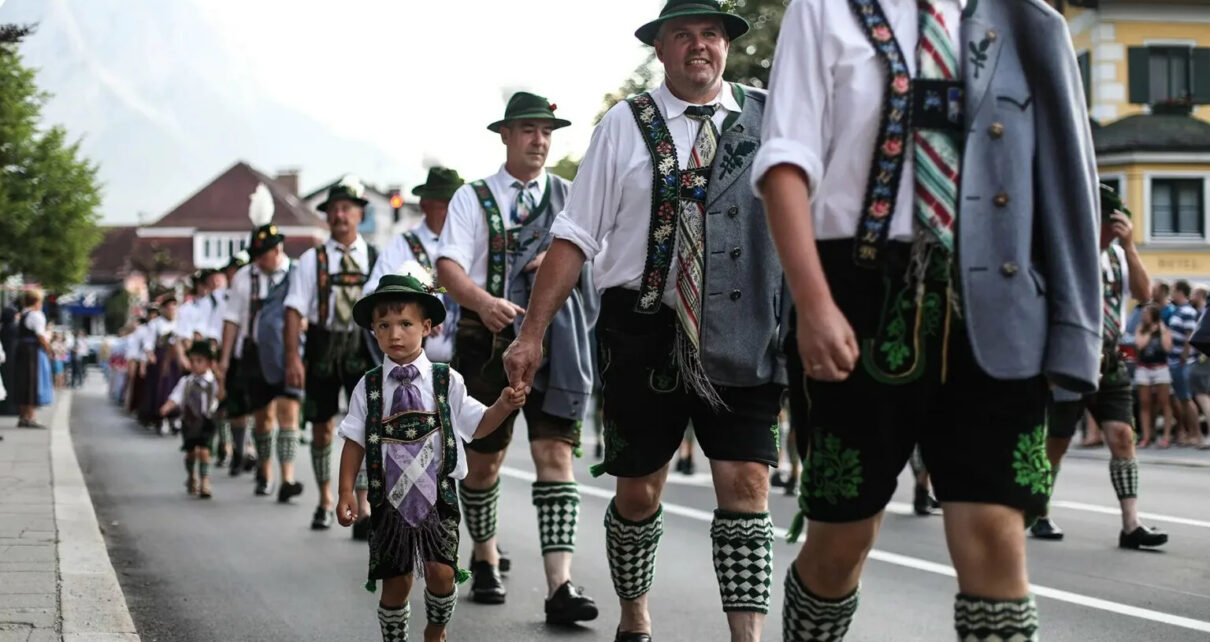The Oktoberfest outfit, known as Tracht, is more than just a festive costume—it is a proud and enduring symbol of Bavarian culture, heritage, and identity. Worn during Oktoberfest and other traditional celebrations, the classic Lederhosen for men and Dirndl for women have a rich history that dates back centuries. These garments represent not only fashion but also Bavarian pride, craftsmanship, and a deep connection to the past. Let’s explore why the Oktoberfest outfit remains a vital part of Bavarian culture and how it continues to thrive in modern times.
1. A Reflection of Bavarian Heritage
The Oktoberfest outfit is deeply rooted in Bavarian history. Lederhosen, originally worn by peasants, hunters, and laborers, were designed for durability and comfort during physical work. Over time, they became a status symbol among the upper class, featuring intricate embroidery and fine leather craftsmanship.
Similarly, the Dirndl began as a functional dress for farmworkers and maids, but it soon evolved into a fashionable ensemble worn by women of all social classes. Today, both Lederhosen and Dirndls reflect a strong connection to Bavaria’s past, making them a meaningful tradition rather than just a costume.
2. A Symbol of Regional Identity and Pride
Bavarians take immense pride in their traditions, and the Oktoberfest outfit plays a key role in preserving regional identity. Wearing Tracht at Oktoberfest and other festivals is a way for Bavarians to celebrate their history, unify their communities, and pass down traditions to future generations.
Unlike fleeting fashion trends, Lederhosen and Dirndls have remained timeless, reinforcing their importance as a cultural emblem. Visitors from around the world also embrace these outfits, helping to spread Bavarian traditions beyond Germany.
3. High-Quality Craftsmanship and Tradition
The Oktoberfest outfit is known for its exceptional craftsmanship. Traditional Lederhosen are made from high-quality leather, often handcrafted by skilled artisans. The embroidery and detailing on Lederhosen often symbolize Bavarian regions and family heritage, making each piece unique.
Similarly, Dirndls are crafted with great attention to detail, using materials such as silk, cotton, and lace. Many families pass down their Tracht through generations, emphasizing its lasting value and significance.
4. Oktoberfest and Beyond: A Celebration of Culture
While the Oktoberfest outfit is most commonly associated with the world-famous Munich Oktoberfest, it is also worn at other Bavarian events, including weddings, folk festivals, and traditional dances. These occasions showcase the rich cultural fabric of Bavaria and reinforce the role of Tracht as an essential part of community celebrations.
Additionally, the way a Dirndl’s apron is tied carries cultural significance—tying it on the left indicates a woman is single, while tying it on the right signals that she is taken. Small traditions like these keep the cultural meaning of the outfit alive.
5. A Fashion Statement That Blends Tradition with Modern Trends
Though rooted in tradition, the Oktoberfest outfit has adapted to modern fashion trends. Designers have introduced variations such as:
- Shorter Dirndl skirts for a more contemporary look.
- Bolder colors and patterns beyond the traditional earth tones.
- Customized embroidery to add a personal touch.
- Stylish accessories like Alpine hats, leather belts, and decorative brooches.
For men, modern cuts and styles of Lederhosen make them more comfortable and versatile, appealing to younger generations while maintaining their cultural significance.
6. A Global Influence: Oktoberfest Celebrations Worldwide
Oktoberfest is no longer just a Bavarian celebration—it has become an international phenomenon. Cities around the world, from the United States to Australia, host their own Oktoberfest events, where attendees embrace traditional Bavarian attire.
The global popularity of these outfits has helped spread awareness of Bavarian traditions and craftsmanship, ensuring that the legacy of Tracht continues to thrive far beyond Germany’s borders.
7. Sentimental and Emotional Value
For many people, wearing an Oktoberfest outfit is about more than just dressing up—it is a way to connect with history, family, and tradition. Many individuals have inherited Lederhosen and Dirndls from past generations, making them cherished heirlooms.
The emotional attachment to these garments fosters a sense of belonging and nostalgia, strengthening the role of the Oktoberfest outfit as an integral part of Bavarian culture.
8. Sustainability and Longevity
Unlike fast fashion, Oktoberfest attire is designed to be durable and long-lasting. Traditional Tracht is made from high-quality materials that can be worn for decades, reducing waste and promoting sustainability.
As the fashion industry moves towards more eco-friendly practices, the Oktoberfest outfit stands out as a sustainable and ethical choice—one that celebrates heritage while minimizing environmental impact.
Conclusion: A Timeless Tradition That Lives On
The Oktoberfest outfit remains an important part of Bavarian culture because it represents heritage, craftsmanship, community, and pride. Whether worn in Munich or at Oktoberfest celebrations around the world, Lederhosen and Dirndls continue to honor Bavaria’s rich history while evolving with modern trends.
By blending tradition with contemporary style, these iconic outfits maintain their cultural significance, ensuring they remain a treasured part of Bavarian identity for generations to come. Whether you are a local or a visitor, wearing Tracht is a way to immerse yourself in Bavarian culture and celebrate Oktoberfest in true traditional style.




